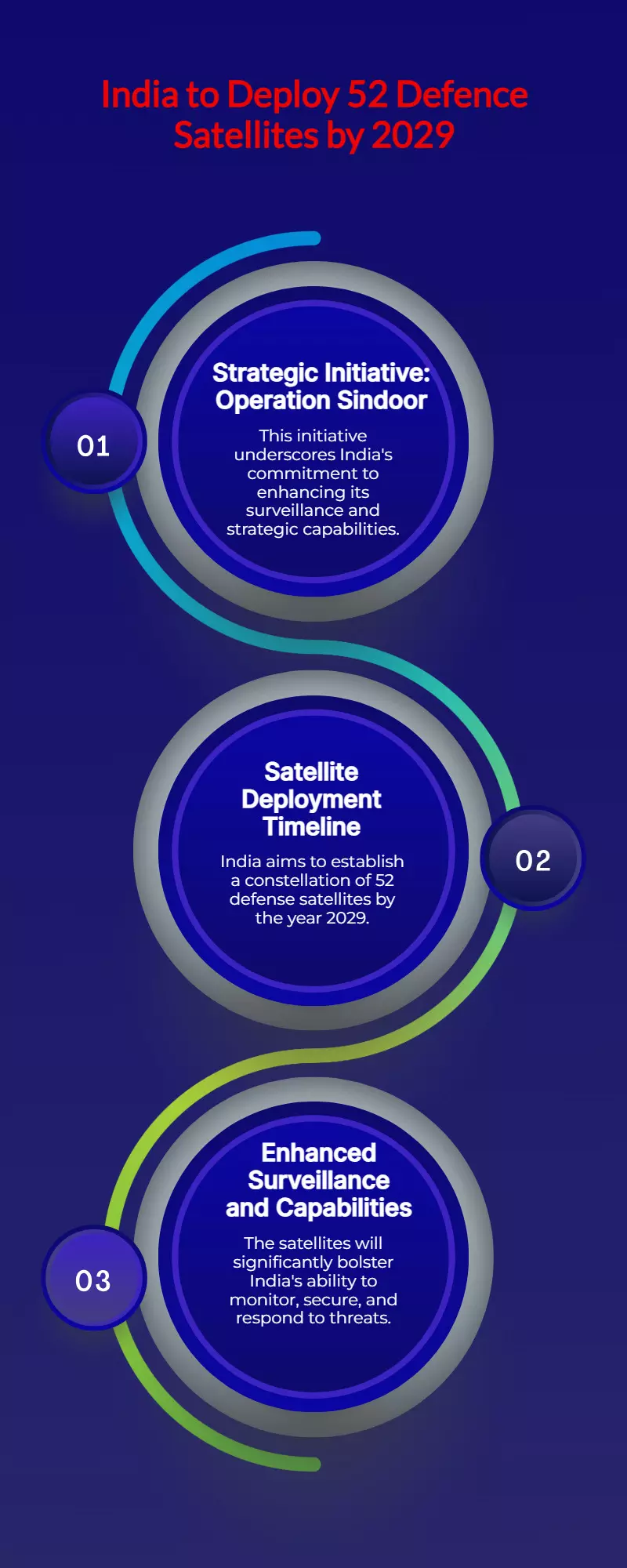India Plans 52 Defence Satellites by 2029 After Operation Sindoor Push

By : Krishna Mishra
India’s Space Defence Surge: 52 Satellites Planned by 2029 After Operation Sindoor Wake-Up Call
India is set to launch 52 dedicated defence satellites by 2029 in a major move to overhaul its space-based surveillance capabilities, spurred by operational lessons from Operation Sindoor—a high-intensity military engagement with Pakistan between May 7–10, 2025. The ambitious initiative is being steered by the Defence Space Agency (DSA) under the Integrated Defence Staff and is part of the ₹26,968 crore Space-Based Surveillance Phase 3 (SBS-3) programme.
What Is SBS-3?
Cleared by the Cabinet Committee on Security in October 2024, SBS-3 aims to strengthen India’s real-time intelligence and tracking abilities across China, Pakistan, and the Indian Ocean Region (IOR). The plan involves:
21 satellites to be developed by ISRO,
31 satellites by three private Indian firms,
The first satellite launch is targeted for April 2026.
Senior officials confirmed efforts are underway to compress timelines, ensuring faster deployment in Low Earth Orbit (LEO) and Geostationary Orbit (GEO).
“The goal is to ensure persistent, high-resolution coverage with faster revisit times across critical adversary regions,” said a defence official.
Strengthening the Sky: HAPS Deployment
Alongside satellites, the Indian Air Force is also acquiring three High-Altitude Platform Systems (HAPS)—long-endurance pseudo-satellites capable of operating in the stratosphere. These UAVs will act as complementary ISR (Intelligence, Surveillance, and Reconnaissance) platforms, offering sustained monitoring over conflict zones.
Operation Sindoor: A Wake-Up Call
During Operation Sindoor, India relied heavily on Cartosat-series satellites and foreign commercial imaging to track cross-border activity. However, the episode revealed gaps in real-time surveillance, prompting urgent upgrades.
“We must compress our OODA loop—observe, orient, decide, act. The 52-satellite constellation is key,” another official emphasized.
Facing China’s Space Militarisation
India’s push comes amid China’s aggressive military expansion into space. From just 36 military satellites in 2010, China now operates over 1,000 satellites, including 360+ for ISR, and advanced space weapons such as:
ASAT missiles,
Co-orbital satellite weapons,
Electronic warfare tools,
Laser-based directed energy weapons.
China’s People’s Liberation Army Aerospace Force (PLAAF), established in 2023, reflects Beijing’s view of space as the "ultimate high ground". Their satellites now perform combat-style manoeuvres in orbit, testing interception and tracking tactics.
A Strategic Pivot
IDS Chief Air Marshal Ashutosh Dixit stressed the importance of pre-emptive intelligence:
“We must detect threats deep within enemy territory—not just at the borders.”
He warned that China's "kill chain" had evolved into a "kill mesh"—an integrated web of space-based ISR and offensive systems. India’s SBS-3 aims to build a comparable network of satellites and airborne platforms to protect national interests.
Conclusion
The SBS-3 project marks a decisive step in India’s space militarisation strategy, blending satellite constellations and stratospheric UAVs into a robust, responsive ISR framework. Born out of necessity and sharpened by conflict, India’s space defence roadmap is now aligned for a multi-domain future, ensuring dominance from land to orbit.
